And will the ‘solutions’ solve anything??
Christopher Hector asks some of the world’s experts…
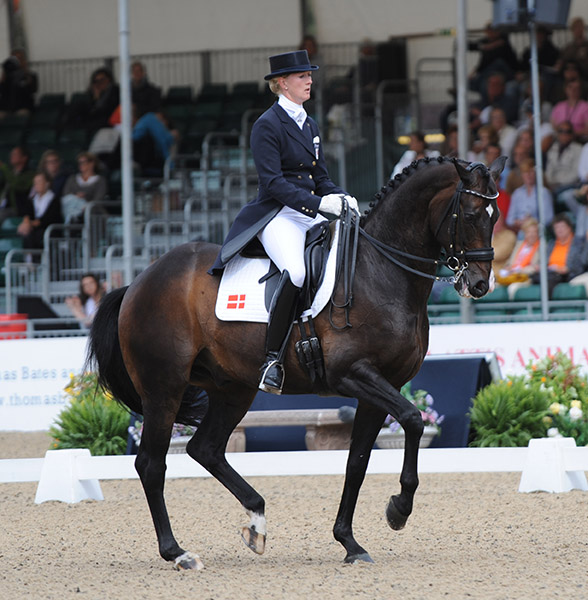
Princess Nathalie zu Wittgenstein has recently traded her international competitor status for the rôle of Danish Team coach after a distinguished career that saw her compete at two Olympic Games (Beijing / London), four WEGs (Jerez / Aachen / Lexington / Normandy) and four World Cup Finals – finishing second with Digby, the horse her mother bred, at the Leipzig final of 2011. I’ve always found Nathalie a breath of fresh air on the dressage scene, she thinks deeply and is prepared to speak her mind.
There seems to be a largish campaign on the internet at the moment to spread the idea that there is a crisis in dressage judging, and we are being offered a number of solutions that mainly seem to involve mathematicians or smart apps – are things really that bad?
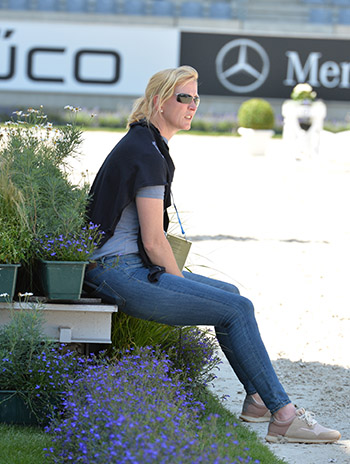
“I think the crisis creates itself in a way. I think it is good that we talk about judging, and that the judges are open so you can actually talk to them. You have to be able to go up to them and say, hey, why do you see it this way? Why that way? Why did you give that mark, or that mark? A lot of judges are opening up and being a lot more talkative. Others are still holding back, or trying to defend themselves whatever they do.”
“I think it is dangerous what is going on at the moment, the changes suggested not going to help. In my opinion, educating the judges is the main point. The old system does actually work, but the judges just have to know exactly how to use the manual. There are judges who use the manual really well and then there are judges who don’t use the manual very well. The five-star judges have to go on one line and say, hey, what do we want to see, what don’t we want to see, and then they have to stick to that. That’s my opinion. You can still have differences in the old system, they just have to know what they want, and what they want to see.”
What do you think of Katrina Wüst’s system, of putting in a floor plan and assessing the degree of difficulty before the freestyle test?
“I think that’s really good because finally the judges can say, this is difficult, this is not difficult. If you compare the freestyles Anky had with Bonfire, or Salinero, to Isabell’s freestyles, there is a huge difference in the degree of difficulty. Anky was riding an M class, and Isabell was actually riding Grand Prix.”
Well here’s the lady herself, Isabell Werth, what does she think? Is there a crisis in judging, I don’t see it…
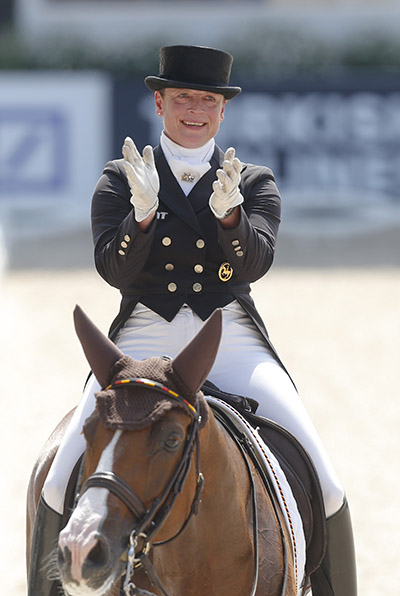
“I don’t see it either. We have always had discussions. I agree that we always have to discuss, what can we do better, but I can’t see it’s a solution to take off the highest or the lowest scores, because in the end it is important that you have the view of all five judges, just because from the side it can be a totally different view to the view at C. It’s not a joke, it’s true – and some horses are more difficult to judge from the side. I think it would be sad to take off the mark of the lowest judge, when this might be the right mark from his point of view. Or to take off the highest mark – on one hand, we want to have higher marks, we want to have top sport with 80% or more – why make the judges afraid to give a big score, frightened that it will be taken away. Why? This is not the solution.”
“The way I see to improve the judging, and we have many more judges from the smaller countries where they don’t have so much experience, don’t have the basic like we have, is education. Education, mentoring for judges and there should be a panel that is allowed to sanction judges if there is really bad judging, or judging that is too nationalistic, then they have to be removed for a while, like they do in soccer.”
“For me, the solution is to make it more professional, make a professional panel of judges, rather than judges who have to travel the world balancing judging with their normal job. We need a panel that is more independent and professional.”
“These are keys, in my opinion, where we can improve the judging. It’s more improving than saying now we have a crisis of bad judging. We have a completely different basis for dressage now, than we had twenty years ago. Then we had just a handful of nations in dressage, now we have a much more global sport, with many more nations, and we have to educate the weaker judges instead of looking for another judging format.”
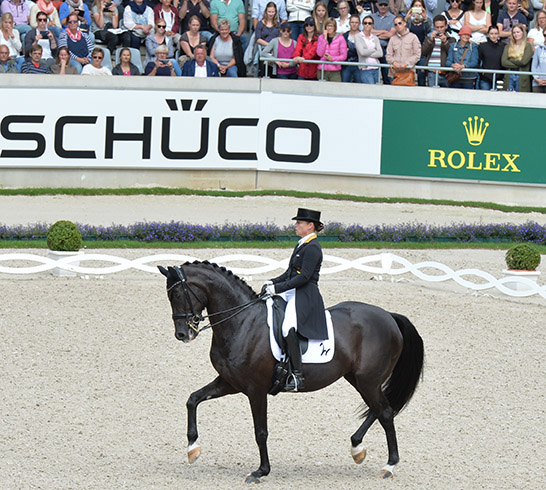
“We tried in the past taking away the highest and the lowest scores, it’s a bit like four riders in a team, three riders in a team, three and a half riders in the team like in London… Sometimes it seems, oh we have a new director, a new president, so we have to change the format again – just to change something. Since I’ve been in the sport I don’t know how many times they have changed the number in the team, and with what result? We are all sure that four riders in the team is the best solution because it is the fairest solution for everybody. Okay, now we have again, three riders, and I am sure it will be changed once again.”
Do you like the idea of putting your choreography in to the judges before the freestyle test, so the degree of difficulty can be assessed…
“This is a good improvement that we now have a system where we have a clear decision, this degree of difficulty is 9.2 or it’s 8.5, or whatever. It’s clear, it is one step more to make the judging more objective. The freestyle is not as objective as the more classical competitions, but this helps make it a little more objective. It can be really frustrating if you go one week for a 9.5, next week, 8.5, an other week, 7.5 and you have no idea at the end, is your degree of difficulty, high or low. This has happened in the past because it was always a bit more subjective, and now we have an objective schedule and you know if you take this, this, this, in your freestyle, then you can reach this degree of difficulty. That’s a very fair solution.”
Robert Dover has throughout his long career as a competitor and more recently as the coach of the American Dressage team, shown himself to be an independent minded commentator on the world of the horse, what does he think?
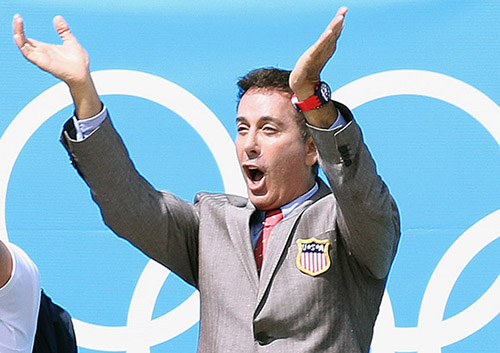
“First of all, I would say we are not in an unprecedented crisis. We have had crises since the first day I can remember competing in my first international competition! In our own minds, as a collective group, we’ve gone through so many things over the years, where we’ve thought, oh no, this could be the end of the sport as we know it – or what’s happening with the judging?”
“I can remember once in 1988 at the Olympic Games in Seoul, saying to a journalist, how is the public supposed to understand how those scores are being given when the riders themselves don’t even understand… Mr Niggli was the head of the Ground Jury and he was standing about two metres away, and over-heard me, and came up and said, Robert you know that’s not very helpful. I said, but Mr Niggli, it’s the truth. This is 1988, so what I am saying is that we go around in circles many times, both literally and figuratively.”
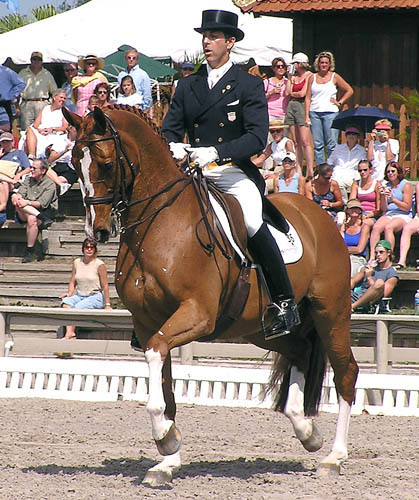
Robert and his last Olympic appearance, with Kennedy at Athens 2004
(photo Kenneth Braddick)
“It’s the nature of our sport, but in the end the suggestions that would end up creating big changes, like the ones you referred to, normally just stay as conversations. They catch the attention more and more of the media, because we have so much more of a minute-by-minute transparency because of the internet. I might say something to you, and instead of taking a week to get in a magazine, now, in one minute, it is published and then there is the conversation. I would say that the conversations are all fine, it unearths more and more possibilities, but in the end, I think, common sense prevails.”
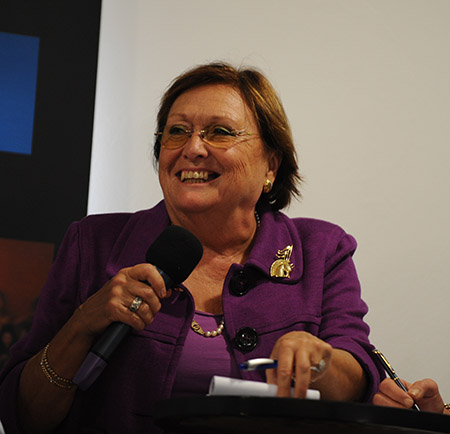
Mariette Withages judged her first international event – the Brussels CDI – back in 1974. She became a five-star judge in 1989, and officiated at two WEGs (Rome and Jerez) was the TD at the Sydney Games and judged at Athens. Mariette was a driving force behind the growth of the Freestyle and with Reiner Klimke and Herman Duckek, was instrumental in setting up the Dressage World Cup. Nowadays Mariette is ‘too old’ (in the opinion of the FEI at least) to judge, but was a member of the World Young Dressage Horse Jury of Appeal, at Ermelo, when I caught up with her.
Is the sky really falling in?
“I don’t believe in a crisis, but what I do believe what we are missing most is more education for the judges – and education is far far far better than any system. You can invent every system in the world, but the human weakness will always be there.”
But can you educate a horseman’s feel? A horseman can look and see tension in a horse, and if a person hasn’t got this eye, I don’t know how you can educate it…
“If there is no material, then you can’t make a suit, and I think every judge is supposed to have the eye because they start in their own Federations with lower levels and education, education, and slowly you climb up the staircase. That means that your eye and your feelings and your knowledge should improve.”
But looking back to the era of Salinero, do you think somehow dressage lost its eye, and a horse that was very tense was winning everything?
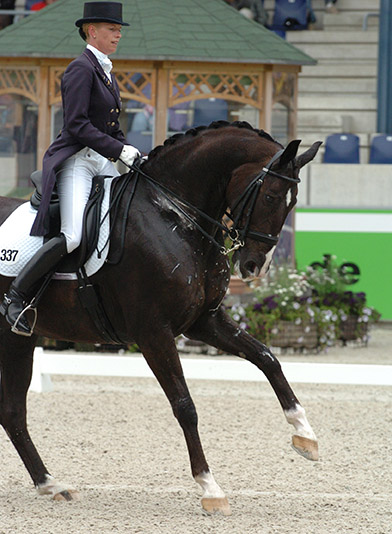
“I don’t think we lost our eye, I think, specially through press, and pressure, that people were more or less forced – and I still believe when I talk to my colleagues, that they still have the eye and still have the feeling, but the people who are insecure, when they have to score, I can understand that they are losing some of their possibilities.”
What do you think about the idea of submitting the choreography before the Kur, so the degree of difficulty can be assessed?
“I think that can have a positive impact, but it is complicated to do it at the smaller shows. For championships, it is not such a bad idea.”
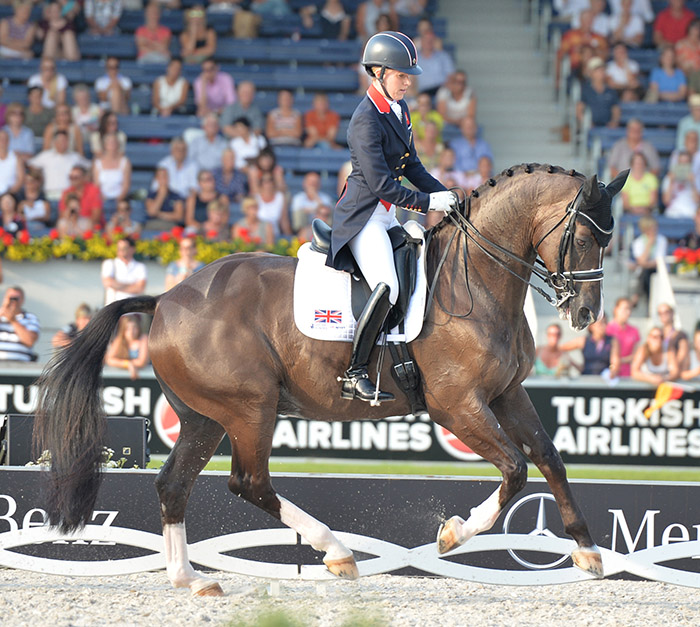
Take away the top score – goodbye stars like Valegro!
What about discarding the top and the bottom scores?
“I have very mixed feelings about this. If the high low system had been in place, ten, fifteen years ago, we would have had no Ankys, no Isabells, no Valegros, because by taking away the high scores, we don’t have stars any more – and our sport needs stars. And if they take away the low score and it is my score because I am sitting on the side and I see the tongue is hanging out, and I give it a four – then we should give it a title: Bye bye stars, hello mediocrity!”
Thinking back, I can remember one Euro Champs, where the Swedish judge was the low score of Delphi – but he was the only one that saw the horse was irregular in the passage…
“It’s not that if you are the lowest, then per se, you are the bad guy or the bad woman.”
You talk about education improving judging, but you have traveled the world for many years implementing education programs, and yet we still get very puzzling decisions at Championships, even at Olympic Games…
“I must say that at the Olympic Games, okay, you can always find some puzzling scores, but if you ask the judges, then you will find a clear answer. Even if there are seven judges, they are still in different positions and you see things from a different angle. You can say this is a cheap excuse, but it is not really, as long as you have judges and it is a judging sport, you will always have some differences, but we should – and this is part of education – after the competition, take the video, take the scores, and talk about it, and the president of the Ground Jury should be responsible for this. There is a rule that if there is a difference of 5% that we must do this, and I think this is a very healthy rule.”
“I don’t believe in major changes in the judging system, I only believe in education.”
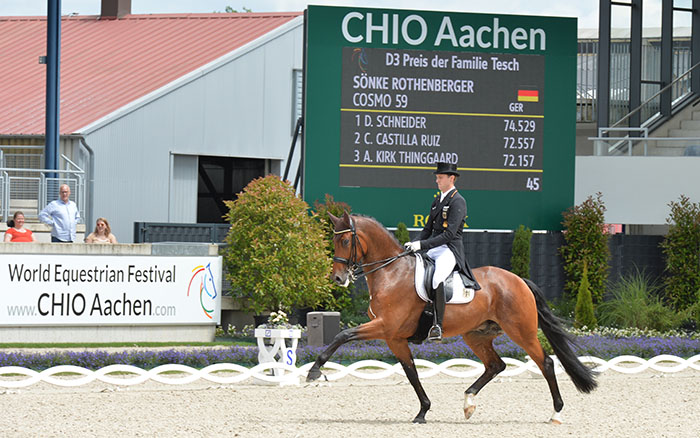
I think quite a few people have been talking after Aachen about Cosmo and the Kür, do you think it takes a new combination a few very good rides before they are really recognized?
“I don’t know who was judging the Freestyle, but if you have judges in Aachen, then they usually know what they are talking about…”
Oh, I remember being at Aachen at a European Championships, where one judge scored a lame black stallion higher than a sound black stallion, and then was promoted to judge at Rio…
“Maybe, but people think you have to find your way first, and start to be famous before you get the scores, but this is not the case, I think. I’m not saying with 100% of the judges, but most of them.”
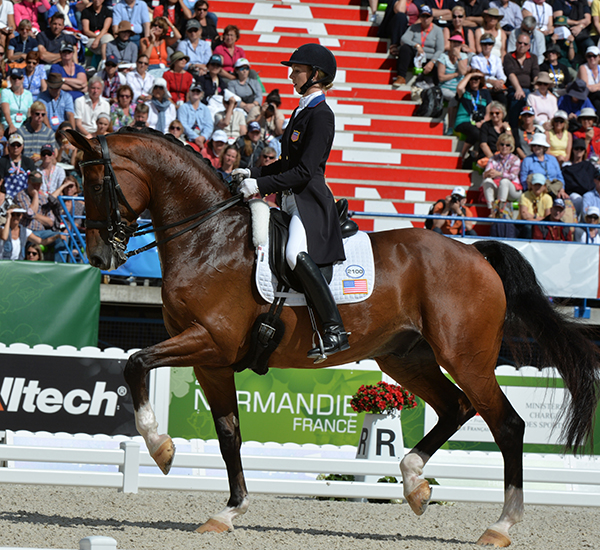
I think back to the last WEG in Caen, where Verdades came out in the Grand Prix and was great, but quite a few of the judges missed him, and only realised what they were seeing in the Special and gave the scores he deserved then…
“That can happen, yes, and then they have to admit it…”
Most times you can pick up individual scores that are crazy, but most times the end result makes sense…
“Yes, that is something that is pretty obvious, that’s true.”
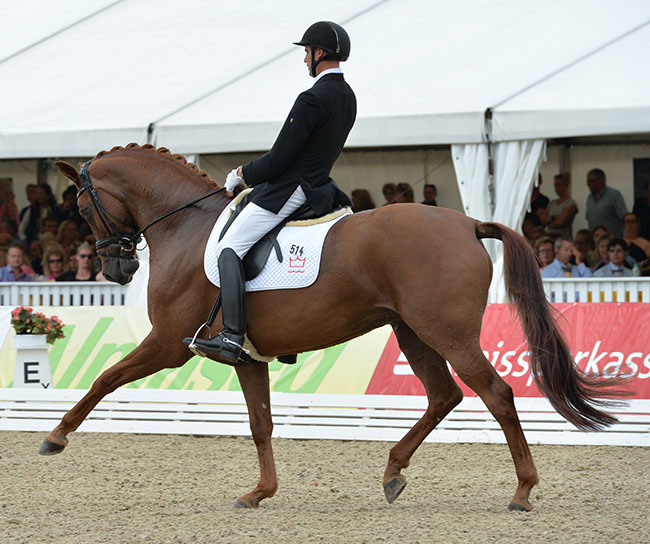
At Verden, and at Ermelo…
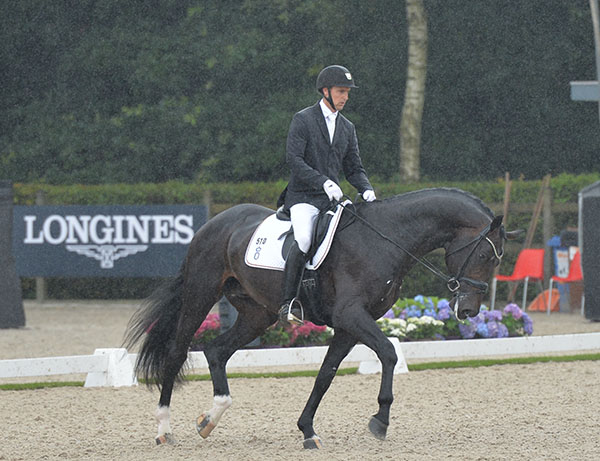
We were talking about Andreas Helgstrand’s test in the Young Horse class here at Ermelo, and this was a very different style of showing from Verden two years ago, does that mean judging is heading in the right direction? Maybe lead by Carl and Charlotte, looking for harmony?
“I should not say this is the new way, this is the way that it always should have been…”
But we did get a little side-tracked…
“I think it was very good that Carl and Charlotte have been successful, and people are really thinking and talking, and they see what dressage is all about.”
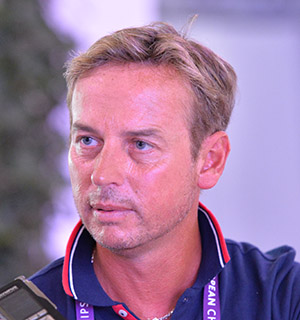
It is interesting that in a recent Horse & Hound op-ed, Carl Hester expressed his concern at the directions the judging debate was heading. Carl said he has no objection to a code of points to guide judges, but was concerned that the discussion had moved to a system based on starting with a mark of 10 and deducting points according to a strict formula.
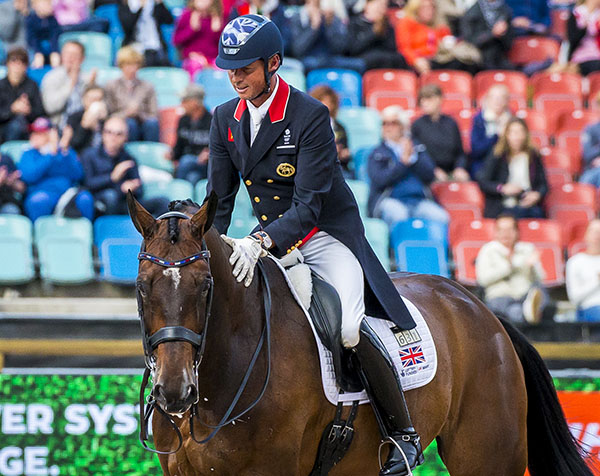
“How can you start from 10 for a horse that is not capable of earning a 10?” Carl asked. He went on to praise the rôle of Eric Lette as dressage chair in the 90’s who pushed to “highlight the positives and drag judging away from ‘policing mistakes'” and suggests that the worst result from the new scenario is “a return to the correct, but ‘clockwork mouse’ type of test, with suppleness, elasticity and expression secondary, or even out the window altogether.”
Christoph Hess follows
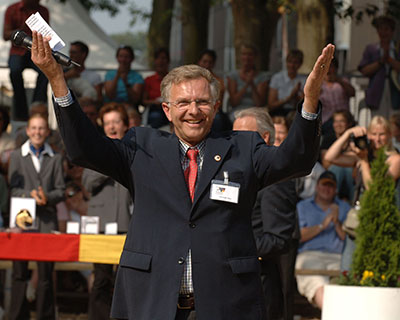
Christoph Hess is another passionate and articulate commentator on the dressage scene. The former head of the Education Department of the German Equestrian Federation, is now busy traveling the world, judging both dressage and eventing, lecturing and teaching – and perhaps most famously of all, acting as commentator judge at events like the World Young Horse Champs.
What does Christoph think? Crisis or no crisis?
“I wouldn’t say ‘crisis’ but I want to say that we always have to discuss very carefully, what we are doing. For me, it is not the decision to have seven judges – I think one judge who is very competent is better than having seven judges. What I think is important, is that we always discuss what we are doing, at the end of the day, the judges should sit together and look very carefully to the marks, to think about it – what can we do better?”
“For example, when a horse has no relaxation, and is not immobile in the halt, you can’t give a mark which is higher than a 5. Sometimes, I see horses like this, get a mark of 6.5 and I think how can this be? What is important is that we have a clear red line – what is sufficient, comma, what is satisfying – and if we have the feeling that it is not satisfying, it is not sufficient, then we have to go lower to a 5 or a 4.”
“On the other hand, we have to be brave, maybe braver, to give really true high marks if we see movements which are, from the scale of training point of view, well done. I must say that we judges are often too much in the middle. We are not good with low marks and we are not good with really high marks. Our mark is too often 6.5, small 7.”
“When you say to me, do we have a problem, for me, that is the main problem. But that’s not a 2017 problem, it’s maybe a problem when we human beings as judge, when we give marks.”
But what of the solutions that are being put forward, drop the high, drop the low, get apps to measure the movements in the freestyle…
“To be honest, I am not a friend of all these technical things. I think each judge’s mark should count because when we put away the highest and the lowest marks, the problem will be that the judges have their own competition, and they say, we have 30 judges, and I am right in the middle, I am the best judge in the world. This for me is not good judging, a judge who is brave enough to give high and low scores, is a better judge than the judge who is always in the middle. When we put away the highest and lowest scores, at the end of the day, we get judges who like to be in the middle. That is a problem.”
Do you like the new system of measuring the degree of difficulty in the freestyle?
“This can work, this is very technical, I know, and if I was the one to make the decision, I wouldn’t do this – I would always put two judges in one judges’ box, six judges in total at B, C and E, one judge is looking more from the artistic point of view and the other, from the technical point of view. I did this pair judging when we had a special clinic in Warendorf with Wim Ernes – it is such a shame that he passed away – but we found this was absolutely the best system. We had a lovely discussion, a very positive, constructive discussion and then, I think we had good marks. We had from our point of view, the right marks, one can concentrate on the music, the artistic impression, the other on the technique.”
“I like this system more than starting with a worked out degree of difficulty. If the computer crashes you have a real problem, so we are going to need a very good computer system, a good computer operator, in every judge’s box. I like more two judges in discussion to produce three results.”
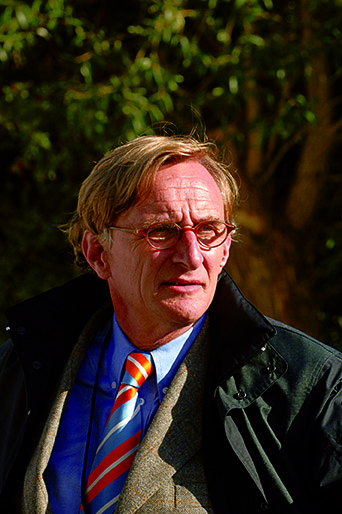
Joep Bartels has been another of the movers and shakers of modern dressage, and was instrumental in the rise-and-rise of the Dutch Team in 2000s, and through his series of symposia at the Academy Bartels, shaped the world’s thinking about dressage…
Is there really a crisis – do we need to hand dressage judging to mathematicians and clever apps to take the human element out?
“This is the all-time discussion, ongoing, nothing new – in a way it belongs to dressage and in a way, it is sad. On the other hand, it is also very interesting and I don’t think it will ever change. I don’t believe in magicians, but all my life I’ve believed in progress, and my life-long belief is that progress comes from looking to other sports, for instance, gymnastics, how do they do it? Then I think progress is possible, and yes, there are a couple of good steps we could take, but I don’t think it’s all that bad, it’s not as bad as they say at the moment, but yes, there is room for progress.”
Do you like the drop the top, drop the bottom score?
“That for sure. It won’t change anything, but it is good for communications, very good for our sport’s communications. It won’t change anything because the statisticians have done the work, and in a competition of thirty riders, it maybe changes one score, but it’s the perspective, the signal it sends to the outside world, so I say yes, because I am looking at it as someone involved in communications. But it won’t improve judging at all and it could even have a slight negative effect, this I totally admit, but for the sport in general, it would be good for outsiders looking at our sport – like the IOC.”
“But there are far more important issues for dressage judging, like a good Code of Points, maybe the distribution of specified tasks between specified judges, which is what is happening in gymnastics. I’m a psychologist and I know the range of attention is much smaller than we think it is. We ask our dressage judges to look to 10,000 things per second, which is impossible. I believe a lot could be done by using psychology to approach the issue, and maybe assign certain tasks to certain judges.”
Princess Nathalie thinks that sports psychologists could work with the judges to give them more courage…
“I am the only psychologist who ever trained 24 ‘O’ judges, twenty five years ago. What I did was get them to write down what they saw in particular images, and 50% saw one thing, and the other 50% something completely different, so you can prove to them, what you see, is not necessarily what there is. What you see is your perception of what there is. You can improve judging by making judges aware of this.”
But the judges must be aware that they will have the tendency to give more marks to Isabell Werth, than someone who is new to Grand Prix…
“It will always be subjective because we are all human beings, but you can be trained to be more objective. Knowing is not everything – there are tools to train towards more awareness, and more awareness slowly brings more objectivity. That’s a psychological way of approaching the whole thing, and as for Nathalie, I have never agreed more with a rider – except maybe my wife. Psychological training, awareness of how perception works, giving tools to prevent too much stereotypical judging, that would be the way. There is the room for improvement, and a good Code of Points, of course. In one hundred years, when we are for sure not here any more, the discussion will still be going on…”
We’ve come a long way from the judging at the Rome Olympics, where it took two days to develop the film and four days for the judges to arrive at a result…
“It’s so much better than it was. You and I were there and we saw decisions that were totally crazy. You don’t see that any more, you see individual mistakes but it is not at all a disaster, not at all, but there is room for improvement.”
Where to now?

As you will see below, there have been dressage judging crises, ever since dressage tests began. But it’s not good enough to throw one’s hands in the air and say, it was always thus. There are powerful forces in the Olympic ‘family’ that would dearly love to kick equestrian out of the Games, in fact, no matter how many concessions the FEI makes, they probably will.
If we are to have a hope of surviving, then strong and well-funded NFs should take under their wings weaker nations on the brink of being ready to participate in the Games. This should not be via the FEI’s shoddy method of simply reducing the number of horses per team to sneak in new teams to compete in competitions that have been dumbed down to allow them to participate. It should be done by genuinely helping bring the riders in other countries up to standard.
For instance, in my country, Australia, we have good eventing competitions and a number of competent trainers. So if we took on squads of eventers from Malaysia, Singapore, Indonesia, Thailand and the Phillipines, and placed them with carefully screened and supervised trainers, then when the vote to kick equestrian out came to an IOC Congress, the representatives of those countries might feel that their countries were very close to making it to a Games, and vote to keep equestrian in. America could take South and Central America, Germany / France / Britain, could divide up the emerging Eastern European countries amongst themselves, and so on.
Alois Podhajsky in the history outlined below, called attention to the lack of riding expertise in the ranks of the judges, and this problem continues to today. The people you would really like to see in the judges boxes, are too involved with competitors and competing teams, so we end up with a group of – at best – struggling small tour riders from that very narrow group, the affluent middle class with the time to spend traveling the world, to get the brownie points to move up the ladder. Perhaps we should think about ways of making judging a more attractive proposition to young judges with an independent eye (yeah, who gets to make that call?)
I think we should consider the attempts in the 50’s and 60’s to film and review the tests – with today’s technology, it would not delay the mark-giving too much if a judge wanted to instantly review a movement that they were not sure of. I hear what both Christoph and Col. Podhajsky say about collective (ie. the judges discussing to come to an agreed mark) judging and think we should trial it and see what happens…
I think both Nathalie and Joep are onto something with the idea of sports psychologists to work with judging panels at the championships, to give them the confidence to trust their eyes – which we hope, thanks to Mariette’s education programs, are suitably informed. And judges who do reveal themselves susceptible to PR and pressure, like the ones that marked up Totilas at the Aachen Europeans, should be suspended for a decent period of time to ponder the error of their ways. This also requires a chief judge, like Eric Lette, with the force of his own convictions and the ability to pull a jury together.
The attempt to automate judging, to take it out of the human dimension, comes from those who can only see the form, not the reason. Nose must be on the vertical, absolute? No, there might be a moment where a horseman, but not a machine, will make allowances.
The truth is, as all the participants in this little ‘seminar’ have stressed, is that while we can point to the odd crazy mark (do we think Podhajsky’s idea of placing marks rather than the actual scores – see below – might be worth re-visiting?) most of the time, the end result comes out just about right. Like they say, if it ain’t broke, don’t try and fix it, especially not with a gimmicky little set of ‘solutions’ from failed riders with a chip on their shoulders, maths experts dazzled by their own brilliance, snake oil salesmen who just happen to make apps, and headline hungry ‘journalists’ (bloggers?) looking for some cheap publicity.
But now let’s see what Col. Alois Podhajsky had to say on the matter fifty years ago…
a bit of history follows
Dressage Judging – A history
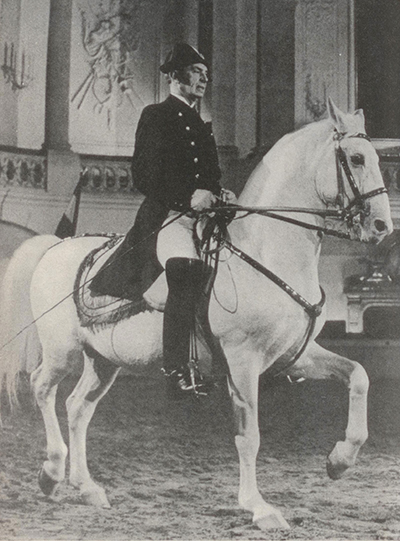
According to Alois Podhajsky in his The Art of Dressage – Basic Principles of Riding & Judging, dressage tests originated in Austria, although the great man, Olympic medallist and head of the Spanish School in Vienna, did not like the term, dressage. He complained ‘The term dressage is not too happy a one, for it suggests something like the drilling of a poodle, that is, the very opposite to what is expected from training a horse according to the principles of classical horsemanship. But since the term has become the international one for this kind of riding, we must accept it.’
Since this book is long out of print and generally unavailable, I will quote extensively, so that the wisdom is not lost…
These first dressage tests consisted of a preliminary and a principal test.
“In the preliminary test the competitors in turn rode upon command a program composed by one of the judges shortly before. A jury consisting of one to three judges evaluated the performance and decided the placements of the contestants. In the principal test, which was ridden on the show grounds before the public, all riders had to present their horses in a group and upon command. This presentation in a group gave an opportunity to watch the behaviour of the horses under varied conditions and afforded a comparison of the performances of the different riders.”
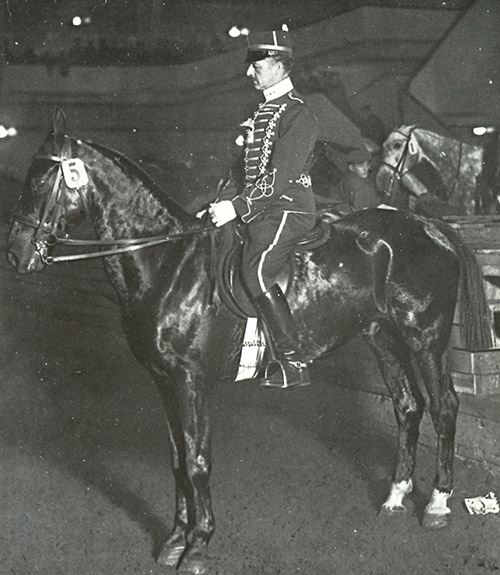
Gold at the 1912 Games to Captain Count Bondé and Emperor (Sweden)
One early decision was whether to use combined or separate judging. Combined, the judges all sat at one table, and came to a score together. The president would dictate to his secretary remarks about the rider’s performance and training advice. Podhajsky was again the sceptic:
“It cannot be emphasized too often that the records must be clear, comprehensible, and unequivocal in order to fulfill their purpose as a guideline for the rider. It frequently happens, however that the records are nothing more than a maze of complicated technical terms and pompous phrases which are no use to the rider and only confuse him.”
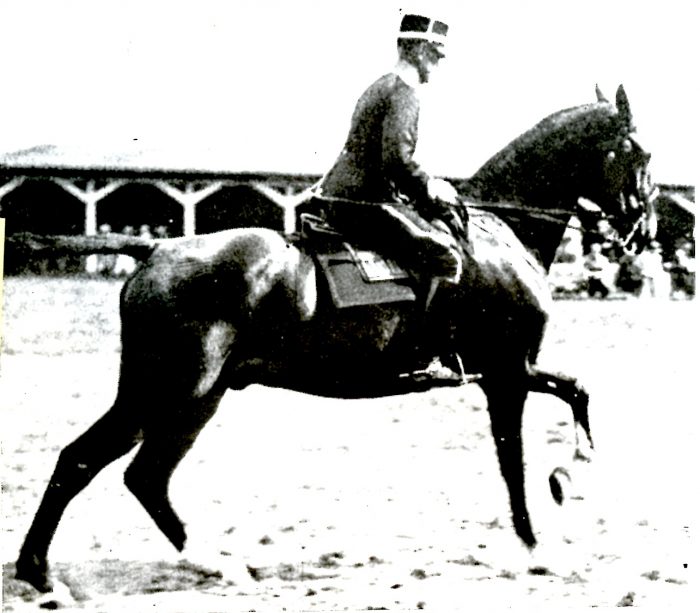
It’s gold to the Swedes again, this time Antwerp in 1920 – Captain Lundblad and Uno
Writing in 1974, the Colonel obviously had an uncanny ability to look into the future… And of course the fence-sitters were always with us:
“There are faint-hearted judges who never venture beyond the marks of five and six. This leads to the obvious conclusion that these judges lack equestrian knowledge or the courage of their opinion. Or both.”
Here we see how we have progressed over the past 50 years, our faint-hearted ones tend to go 6.5 to 7!
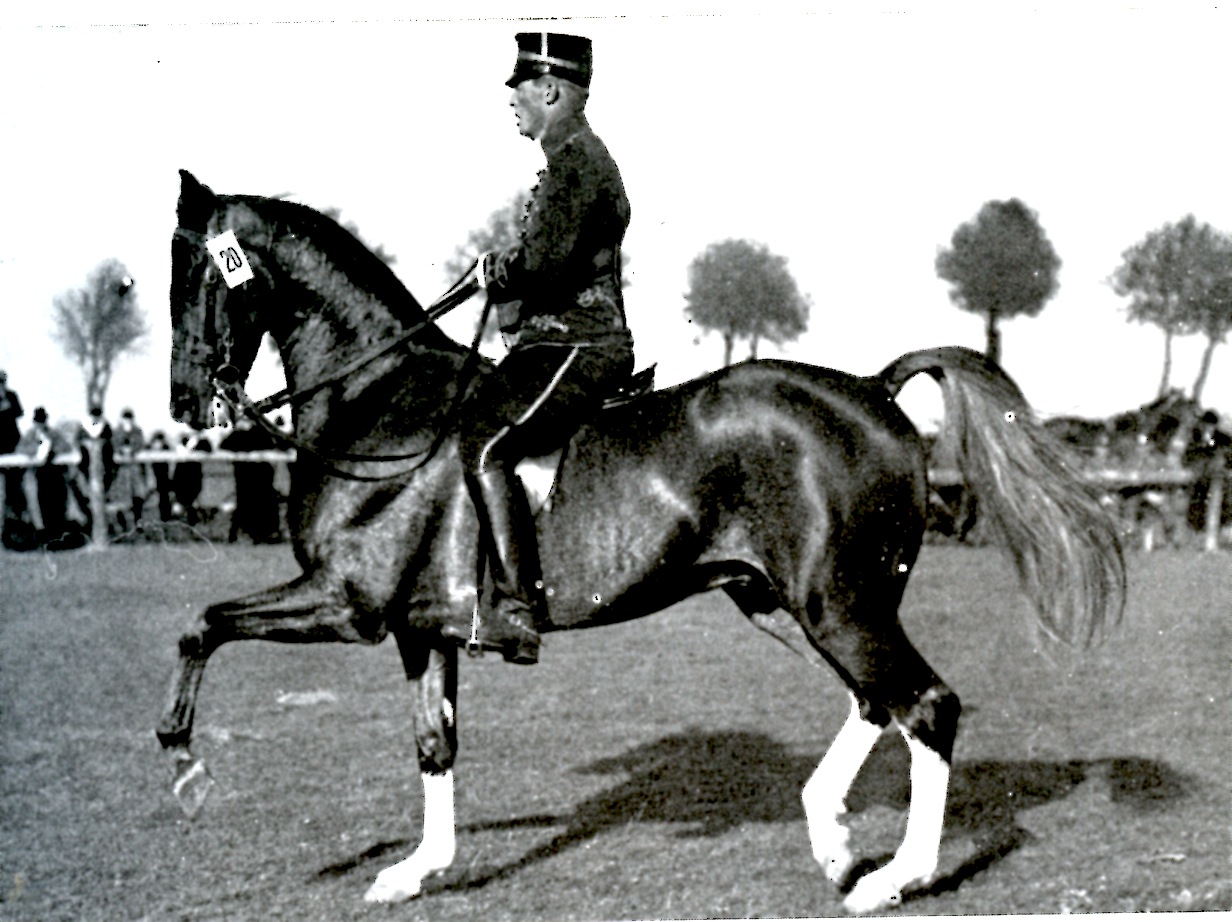
This is an interesting look – Lieutenant Sandström and Sabel – silver in 1920 and 1924
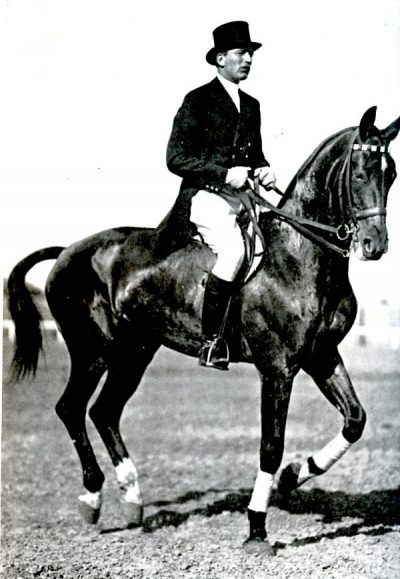
And gold for Germany’s Baron von Langen on Draufgänger at Amsterdam in 1928 –
the German team also won gold for the first time
The issue of whether the judges’ scores should be revealed to the spectators also has a long long history:
“As early as the beginning of the thirties at the conference in Paris, the Austrian representative to the FEI, General von Pongracz, proposed the method of open judging with the scores made public immediately after each ride. A similar system was already in use in skating competitions. General von Pongracz had been an active rider from his earliest youth into advanced age. Well-known in international jumping competitions, he had won the record for the high jump in 1913. In 1936 in Berlin at the age of seventy-two, he placed sixteenth in a field of twenty-nine riders.”
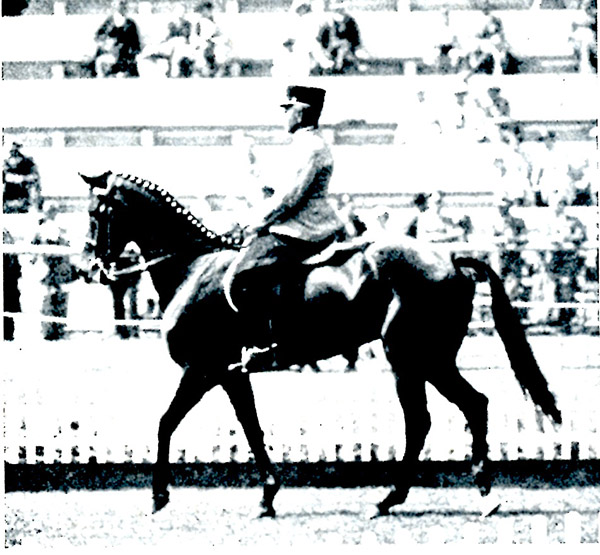
Riding at the Berlin Games in his 72nd year, General von Pongracz and Georgine
“Repeatedly General von Pongracz brought his suggestion up before the assembled members of the FEI. Finally it was turned down with the explanation that in case of erroneous judgement there might be demonstrations of displeasure from the public which would be detrimental to the sport of riding. The General was not the man to be put off with such shabby excuses. He declared in his stentorian voice: ‘The rider stands in the spotlight of public opinion. And so does the judge. The public has a right to express its opinion about any bad behaviour of a rider. In the same way it may stand up against an obviously unjust decision from a judge. In such cases it is of no interest whether the misjudgement springs from a lack of knowledge or from a weak character. A judge like that should be eliminated from the jury.'”
And Podhajsky was a visionary:
“The system of separate judging as practised in Munich in 1972, did not quite meet expectations. The results – the sum of forty-two marks – were made known after each rider had completed his test. Nevertheless, from the mere publication of the results very few spectators were able to obtain a clear picture of how these results were reached or to assess the attitudes of the judges towards the principles of classical horsemanship and the regulations of the FEI. With our highly developed technology, however, it should be possible to announce the marks for the various groups of exercises publicly and immediately by way of luminous digits. Instead of putting down the marks on a test sheet the judge should make them visible on a large board by pressing the appropriate electric button.”
It seems that the controversy was always with the sport:
“The verdicts in dressage tests – at the Olympic Games, or in other international or national events – have in most cases through the years been unsatisfactory and sometimes even downright unavailing. Thereby misunderstanding between rider and judge has sprung up and the gap has deepened ever since. The general public in most instances cannot follow the judge’s ideas either.”
Up until the 1936 Games, the tests were called and interpreters provided, however this was changed for Berlin and the riders had to ride from memory. It was not an unmixed blessing according to Podhajsky:
“Learning the test by heart causes the rider to repeat it far too often during training. This may easily lead to mechanizing his horse, a dangerous direction for a rider to take and one that must be condemned from the point of view of serious schooling.”
But he liked the new test: “The requirements of the dressage riders were increased from one Olympics to the next and reached a climax in the 1936 Games when movements of Haute École such as pirouettes, flying changes at each stride, piaffe, and passage were included in the program. I want to underline particularly that this dressage test did justice to the principles of classical riding in every respect, allowing sufficient space for the basic requirements expected from a dressage horse such as the purity of the paces, impulsion, suppleness and so on.”
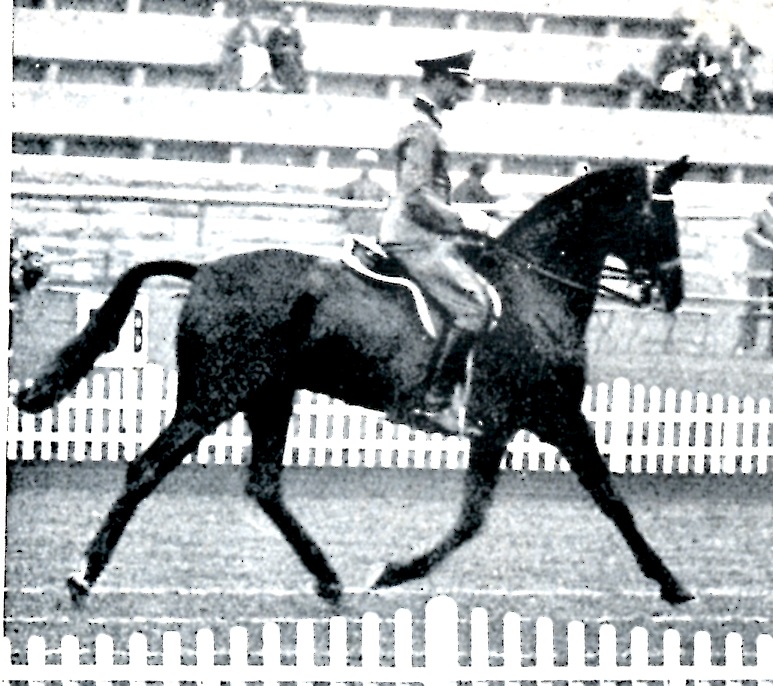
Gold in 1936 to Oberleutnant H. Polley and Kronos from Gustav Rau’s book, Die Reitkunst der Welt an den Olympischen Spielen 1936. Rau’s note on the extended trot reads: ‘ High degree of energy. Complete equilibrium of the horse. Full harmony between rider and horse.
“It should be mentioned especially that the rider was to guide his horse with the reins in one hand during some of the exercises…. There was an artistic concept in the lay-out of the different exercises. They succeeded each other in harmonious sequence from which no tension might arise and which at the same time offered the judge opportunity to examine thoroughly the standard of horse and rider. It is small wonder that even years afterward experts still stated that the dressage test of the Olympic Games of 1936 was the best designed so far.”
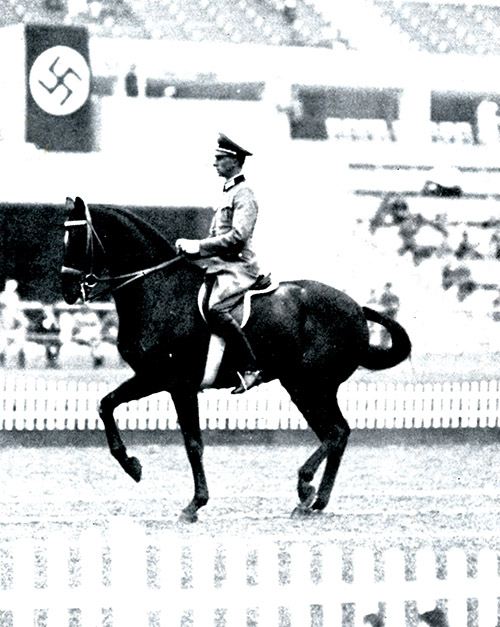
Pollay and Kronos in Piaffe. Rau notes: This performance can be called a perfect Piaffe. Kronos shows plenty of suppleness. He trots on the spot. A wonder of equilibrium. He is doing his task on invisible aids of his excellently sitting rider.
Pollay was placed first with the French judge, General Decarpentry, first with the German, General von Poseck, fourth with Sweden’s Baron von Cederström and Austria’s von Henikstein, and fifth with the Dutch judge, van Ulford.
Five judges for the first time, and they all sat together at a long table on the short side opposite the rider’s entrance. For the first time, coefficients were used, but this caused some controversy since “chauvinistic judges skillfully awarded higher scores to the riders of their own country when there was a high coefficient and lower ones to those competitors who might become dangerous rivals. In justifying themselves they might point out that they had given high marks, too, to the great adversaries of their nation.”
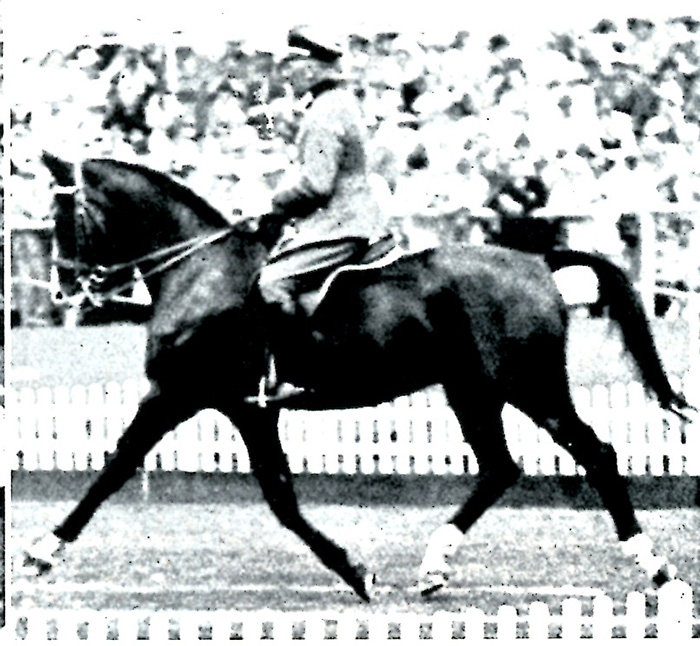
Second place to another German, Major F Gerhard and Absinth. Rau – ‘Brought to the maximum extension’. Gerhard was placed second with the German judge, third with the Swedes and the Dutchman, and seventh with the French judge.
The rider’s final score was determined not by adding up the individual marks of each judge, but by totaling where each judge had placed the combination to find the overall ranking. It was also announced that after the Berlin Games, the highest and the lowest scores would be dropped. Fancy!
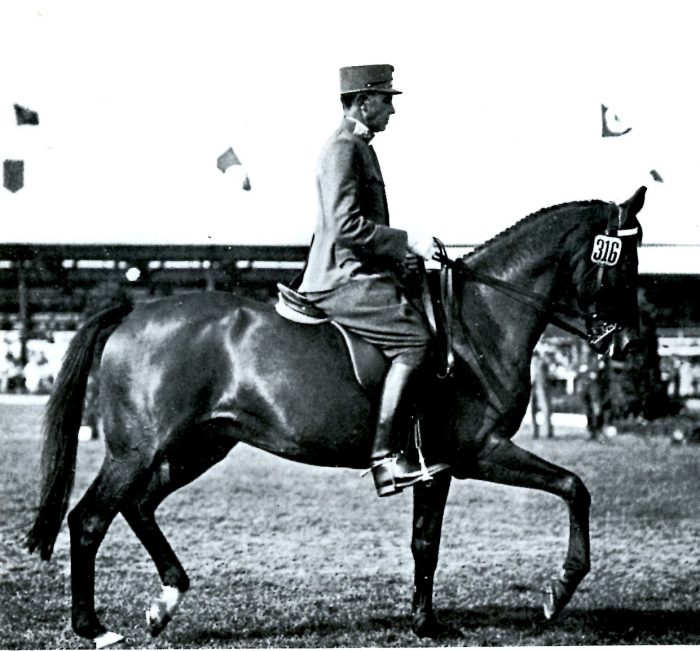
Bronze to the man himself, Alois Podhajsky riding Nero. Fifth with the Swede, fourth with the Frenchman, first with the Austrian, seventh with the German and second with the Dutchman.
more follows
And guess what, judges are influenced by the nationality of the riders:
“In Berlin, every one of the five judges had one or more compatriots among the competitors. Three judges placed their countrymen first, three placed them second. One rider who was placed second by his fellow countryman but ranked seventeenth, twentieth and twice in the twenty-first place in the scores of the four other judges. This was in a group of twenty-nine contestants from eleven nations! Any further comment is superfluous.”
Col. Podhajsky does not name names but a detailed break down of the scores in Gustav Rau’s Die Reitkunst and de Olympischen Spielen 1936, reveals that the offending judge is Sweden’s Baron von Cederström, and combination thus favored, Pergola and Hauptmann F Sandström.
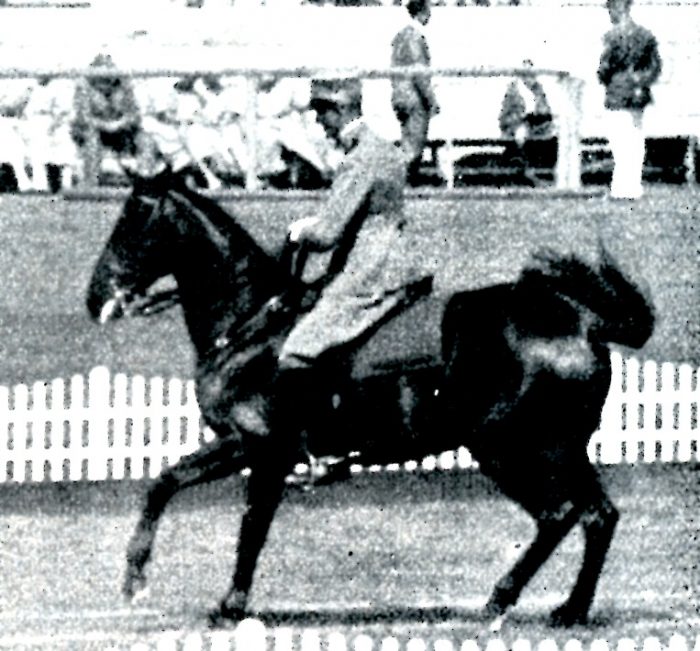
Remind you of anyone? Pergola at the 1936 Games
It would seem that the desire to dumb down equestrian sport has a long history:
“The equestrian standard had sunk to an alarmingly low level as a result of the war. In Berlin in 1936 the horses had not only performed the most difficult exercises brilliantly but had also excelled in the regularity and harmony of all paces. In London, none of this was to be seen although the test had been made considerably easier by eliminating piaffe and passage. And what followed? The subterfuge of a ‘modern concept’ was invented, the ideal of which was presumably to have horses that jogged along without regularity and cadence.”
But the problems with the judges would not go away:
“The jury was reduced to three judges. Two of them placed their compatriots first and second. The third judge had only one rider from his nation and he gave him first place by awarding scores out of all proportion. One rider who had been placed second by his compatriot was put in eighth and tenth places in a field of nineteen riders from nine nations by the two other judges.”
“It was hard to understand why the number of judges was reduced from five to three. A larger jury would have in any case guaranteed a more impartial judgement. A grotesque explanation was given for eliminating place marks, namely that the system of deciding the winner by such marks was not applicable with a jury of three judges. This decision, which was made public at the very last moment, in fact gave one of the judges the chance to give the gold medal to his compatriot whose place mark was nine, while a better rider with the place mark eight had to content himself with the bronze medal.”
“There was great hue and cry and criticism. But the judges or the responsible organization had taken care to prevent all outsiders from having a glimpse behind the scenes. Against all laws of fairness the names of the judges remained a secret even for many months after the Games and in the lists and official reports were supplanted by A, B and C.”
Dressage was on an upward swing by the time the action swung to Helsinki:
“At the 1952 Olympics the Grand Prix was again raised to the level of Olympic standards by reintroducing piaffe and passage, the test was judged by a jury of five, with the highest and lowest scores dropped. Consequently, the scores of three judges only counted for the final results. The place marks were not taken into consideration and have not been reintroduced since. Instead, after each ride the judges compared the marks they had given for the different groups of exercises in the test. The scores had to be corrected in case of a difference exceeding four marks. The test sheet provided a special column for these corrections. As a logical consequence to this procedure, the judge with the greatest experience and knowledge but also with an overpowering personality forced his opinion upon the other members of the jury. Moreover, weak and uncertain judges by wavering between the indifferent marks four to seven, escaped having to stand up for their evaluations to the president of the jury. All in all, this was certainly not a satisfactory solution of the problem.”
“Again the scores of the judges were unfortunately revealed to be of doubtful value. Three of the five judges had compatriots to evaluate and promptly placed them first, although with the other judges they landed in the ninth, eleventh and nineteenth places. Two judges awarded the second place to their fellow countrymen, one of whom placed twentieth with one of the other judges, and that in a field of twenty-seven competitors from ten nations!”
For the 1956 Games, when the equestrian events were held in Stockholm, the test was made more difficult:
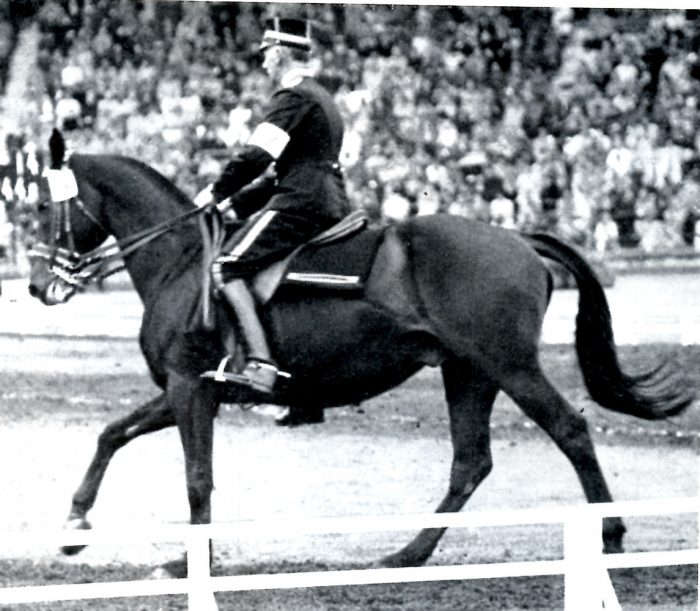
Gold at Stockholm for Henri St Cyr and Juli, for Sweden
“There were flying changes on the circle, for instance, beginning with two four-time changes, decreasing to two changes after each stride, and increasing again to two changes after four strides. This exercise on the circle was highly criticised by some riders who called it a circus trick. However, its performance should be no problem for any dressage horse schooled by the principles of classical equitation, possessing sufficient balance and suppleness, and taking a perfect contact with the bit.”
Guess what? DRESSAGE WAS ABOUT TO BE ELIMINATED FROM THE GAMES! (no we are not talking about the year 2017, we are back in 1956…)
“The behaviour of the jury was in flagrant contradiction to the positive efforts of the organizers. Two of the five judges had no countrymen competing in this test. Two of the other judges considered for medals only their own compatriots, whom they placed first, second, and third, while with the other judges their scores did not amount to more than the eighth, fifteenth, nineteenth, and twenty third places. Most aggravating of all, this happened although for the first time the judges had sworn the Olympic oath for fair and impartial judging! The fifth judge awarded the first place to a contestant from his country while he placed the two other compatriots somewhere in the middle of a field of thirty-six riders from seventeen nations.”
“These incidents at the dressage test in Stockholm aroused general indignation, so much so that the International Olympic Committee was about to eliminate the dressage test altogether from the Olympic Games, an idea that had been considered for some time. Due to the initiative of the president of the Federation Equestre Internationale, H.R.H. Prince Bernhard of the Netherlands, it was possible to ward off this serious blow to the art of riding. Energetic measures were taken on one side and on the other there was readiness to compromise. The two guiltiest dressage judges were barred for life from any further international activity, and each nation was allowed to delegate only two riders to the Olympics in Rome, thereby eliminating any team medals.”
So how did we go in Rome?
“The dressage test was somewhat altered and the time allowed was twelve minutes. Thirty-three groups of exercises had to be evaluated. As an innovation the following Collective Marks were introduced, which at the end of the ride were also to be scored by ten to zero. 1. Paces (regularity and freedom) 2. Impulsion 3. Submission, suppleness, and lightness of the horse 4. Position, seat of the rider, correct use of the aids.”
“To a limited degree the coefficients were reintroduced, that is, the coefficient 2 in seven groups of exercises, including practically all of the airs of the Haute Ecole such as piaffe, pirouettes, and half pass at the canter. The coefficient 3 was awarded for flying changes at the canter at every stride, for the lightness of the horse, and for the rider’s seat and use of the aids. One coefficient of 4 was administered for the Collective Mark given for regularity and freedom of the paces.”
“Another innovation was the ride-off in which 25 per cent of the highest placed riders rode the test for a second time. The final result was deducted from the sum of the scores of both tests. Moreover, films were made of each rider and consulted by the judges before deciding the scores in order to correct their marks if necessary.”
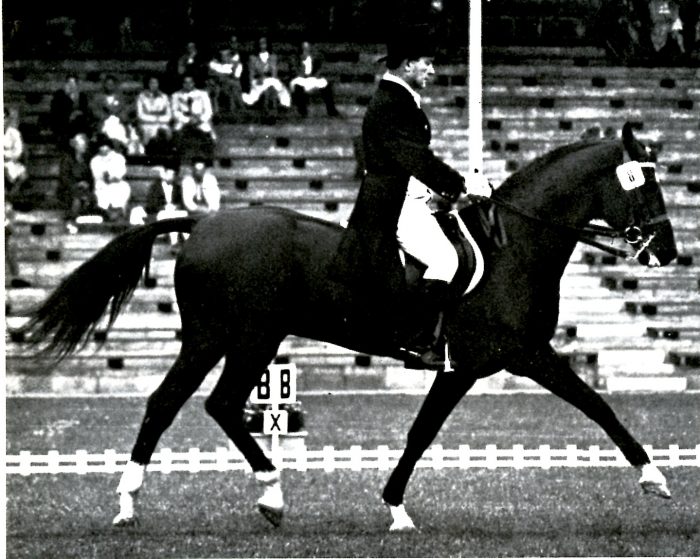
Gold in Rome to the Russian Sergej Filatow and Absent
“This was a rather complicated procedure in theory and in practice it had disastrous consequences. The equestrian standard was of no extraordinary level to begin with. In addition, due to the small entry of only seventeen competitors in an Olympic event together with the complicated system of judging, the interest of the public died down alarmingly. During the test the otherwise overcrowded grandstands began to thin out. The last riders presented their horses in front of rows of empty seats. The results were not published until four days later. This retarded publication and the placements, which were incomprehensible to the experts and to most persons interested in the Grand Prix de Dressage, caused a great deal of justified criticism in the international press.”
“In these Olympic Games three judges assessed the work of years of the best international dressage riders. They came from countries that had not delegated any contestants to the Grand Prix de Dressage. The entire system of judging was surrounded by incredible anonymity. By roundabout means, it was heard that in a special conference the judges consulted films made for that purpose before deciding the final places of the riders. No wonder that the definite results were not made known until four days later. It was a hopeless system which had no place in Olympic Games.”
“Another innovation was the side judge, who, as an observer, was to advise the jury from his point of view whenever disagreements arose. However, he was not authorized to give scores. But again this was not a satisfactory solution to the problem. Nevertheless, the office of the side judge was maintained up to the Games of 1968.”
At the Tokyo Games of 1964, the Grand Prix de Dressage was contested by nine nations (Argentina, Canada, Germany, Great Britain, Japan, Sweden, Switzerland, the U.S.A., and the U.S.S.R.) with six teams of three riders and four individual riders, altogether 22 riders. The individual winners were: 1. Chammartin (Switzerland) on Woermann 2. Boldt (Germany) on Remus 3. Filatow (U.S.S.R.) on Absent. The team medals were won by 1. Germany, 2. Switzerland, 3. U.S.S.R.
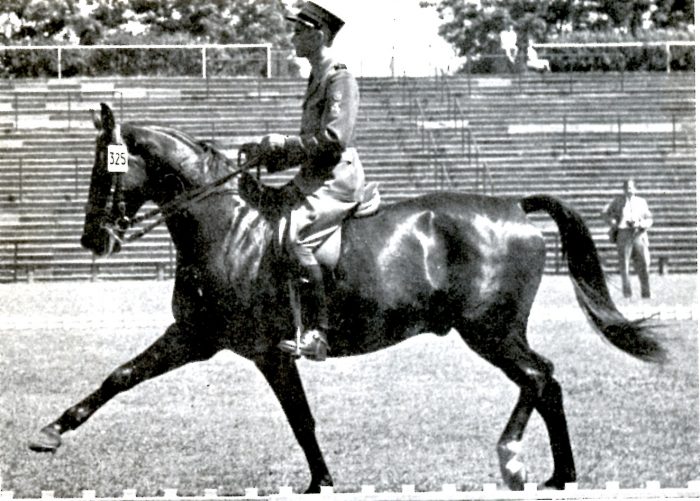
Gold in Tokyo to Henri Chammartin and Woermann – seems spectacular in front,
out behind has been around for a while
“The jury consisted of three judges. Separated from each other, they were to evaluate thirty-two groups of exercises with marks from ten to zero. Again the scores were examined by the president of the jury, who ordered them to be corrected if the comparison revealed gross divergences. The four Collective Marks, three of which were multiplied by the coefficient 2 and one by 3, were determined by the group. Corrections in the test sheets and the final marks given collectively more or less annulled the idea of separate judging. In a ride-off the judges evaluated the better 25 per cent of the participants for a second time. The scores of both rides were added up to determine the final results and the winners of the individual medals. The side judge was again an observer without a vote. The same system was maintained in Mexico in 1968.”
“Since in Tokyo, too, the judges saw films made of each rider before making a final decision, the publication of the results was delayed by days. Again it was a rather un-Olympic procedure. Because of the distance of the Games from my homeland, I could not be present and form a personal opinion. It was not easy to obtain an unbiased over-all view from the various contradicting reports. They were either full of praise, especially about the performances of the reporter’s own countrymen, or full of severe criticism, particularly of the dangerous opponents from other nations.”
“In Tokyo, only one of the judges had to assess his own compatriots. He was straightforward and unbiased, for he placed them seventh, tenth, and twentieth in a field of twenty-two riders from nine nations. A judge should not be expected to rate the riders of his own country with extreme severity in order to prove his impartiality. However, the correctness of this particular judge’s opinion was confirmed by the verdicts of the other members of the jury.”
On to Mexico and the Games of 1968.
Nine nations took part in the Dressage – Canada, Chile, Democratic Republic of Germany, Federal Republic of Germany, Great Britain, Mexico, Switzerland, the U.S.A., and the U.S.S.R. – with eight teams of three riders and two individual riders, that is, twenty-six riders, participated in the Grand Prix de Dressage.
The individual medals were won by: 1.Kisimov (U.S.S.R.) on Ikhor, 2. Neckermann (F.R.G.) on Mariano, 3. Klimke (F.R.G.) on Dux.
The team medals went to: 1. F.R.G., 2. U.S.S.R., 3. Switzerland.
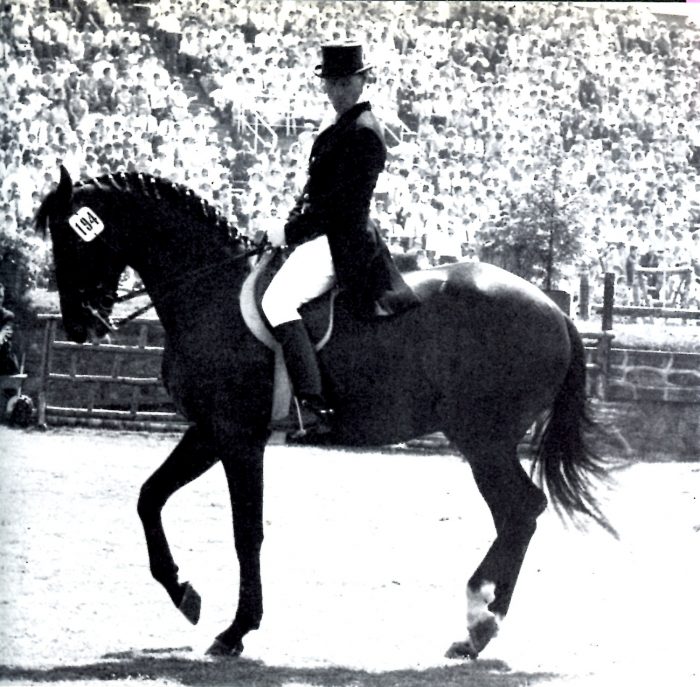
Gold in Mexico for Iwan Kisimov and Ikhor
“The test of the Grand Prix had undergone few changes and consisted of the principal test with thirty-three groups of exercises and the ride-off with twenty-three groups of exercises, as well as the four Collective Marks at the end of each test. Immediately after the principal test the winning teams were determined and the medals awarded. The best 25 per cent of the participants of the principal test was summoned for a ride-off two days later. The sum of the scores of both tests decided the winner of the individual medals.”
“The jury consisted of three judges placed on the short side of the arena opposite the rider’s entrance and of one side judge. After completion of each ride all judges assembled at the stand of the president of the jury and compared their scores. Any considerable divergences were corrected. All four judges together then decided the four Collective Marks, which since 1960 have been part of the scores.”
“Only one of the judges was to judge his fellow countrymen, whom he placed eighteenth, twentieth, and twenty-first.”
“There was extraordinary interest in the Grand Prix de Dressage as evidenced by the crowded grandstands. Unfortunately, the comparison of scores and the determination of the Collective Marks for which the judges met together after each ride took at least as much time as the presentation of the test itself -sometimes as long as half an hour. No wonder that the initially enthusiastic public lost the over-all view since it became impossible to compare the actual presentation of a rider with the final result of his scores. Consequently, the grandstands emptied rather rapidly, as had happened in Rome.”
“When it became known that some of the judges had to correct up to seventeen marks out of thirty-three in the test sheets of one and the same rider, the criticism of the judging system heightened in equestrian circles and also in the hippological press in most countries. I myself had the opportunity to see the three test sheets of one rider. One judge had corrected seven of his marks by adding one or two; another judge by deducting one to three. With such incidents it is certainly not possible to speak about a uniform conception which in fact should be expected in a jury elected by the FEI and subordinate to its regulations. Such abuses did not fail to arouse the FEI, and there were numerous attempts to remedy the system of judging by introducing various changes, which, however, did not always meet expectations.”
Why are we not surprised?
Almost half of Podhajsky’s book was devoted to the Munich Games, no doubt because these were the freshest in his mind – and he had taped his comments on the rides at the time.
Thirteen nations – Brazil, Canada, Denmark, Democratic Republic of Germany, Federal Republic of Germany, France, Great Britain, Japan, Netherlands, Sweden, Switzerland, the U.S.A., and the U.S.S.R. – competed in the dressage at Munich, with ten teams of three riders and three individual riders, competed in the Grand Prix de Dressage.
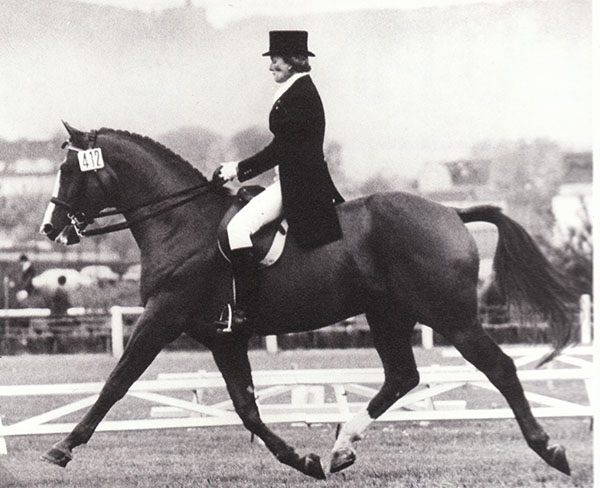
Gold in Munich for Liselott Lindsenhoff and Piaff
The individual medals were won by: 1. Liselott Linsenhoff (F.R.G) on Piaff, 2.. Elena Petuschkowa (U.S.S.R.) on Pepel, 3. Josef Neckermann (F.R.G.) on Venetia
The team medals were awarded to1. U.S.S.R., 2. 2 F.R.G., 3. Sweden.
Again the dressage competition consisted of a principal test and a ride-off. In the principal test the winners of the team medals were determined and the better third of the participants qualified for the ride-off. The time allowed for the principal test was ten minutes. Thirty-eight groups of exercises were to be scored, and four Collective Marks were to be awarded after each rider had finished his presentation.
The ride-off included twenty-four groups of exercises and the same four Collective Marks as in the principal test. The time allowed was seven minutes.
The coefficient 2 was employed to multiply the marks for both pirouettes at the canter and the four Collective Marks, that is, there were altogether six coefficients of equal value.
Podhajsky then under-took an in-depth review of the Grand Prix test:
I make no apologies for the length of this extract, it is a fascinating insight into the thinking of one of the dressage ‘greats’, in fact, if you are really obsessive click here and you will find the test sheets that you can print and compare with the Colonel’s remarks…
“In a dressage test the rider should be given the opportunity to display his and his horse’s abilities. For the judge it is important to gain a clear picture of what is presented in the test. He should form his opinion and find out the reason for faults that occur during the ride. Furthermore, the programme of a test should be laid out with beauty and harmony and correspond to the principles of classical horsemanship. The author or authors of the principal test satisfactorily met the requirements and did justice to the concept of classical equitation.”
“The beginning of the test distinguished itself by a logical structure offering the rider a chance to present the pure paces of his horse with distinct differences of tempo or speed as the horse moved straight forward with impulsion. Impulsion and suppleness in the collected paces present a beautiful sight in which riding approaches the realm of art. Frequent changes of tempo are the best way to achieve the gymnastic training of the horse and at the same time give proof of exactly that gymnastic schooling.”
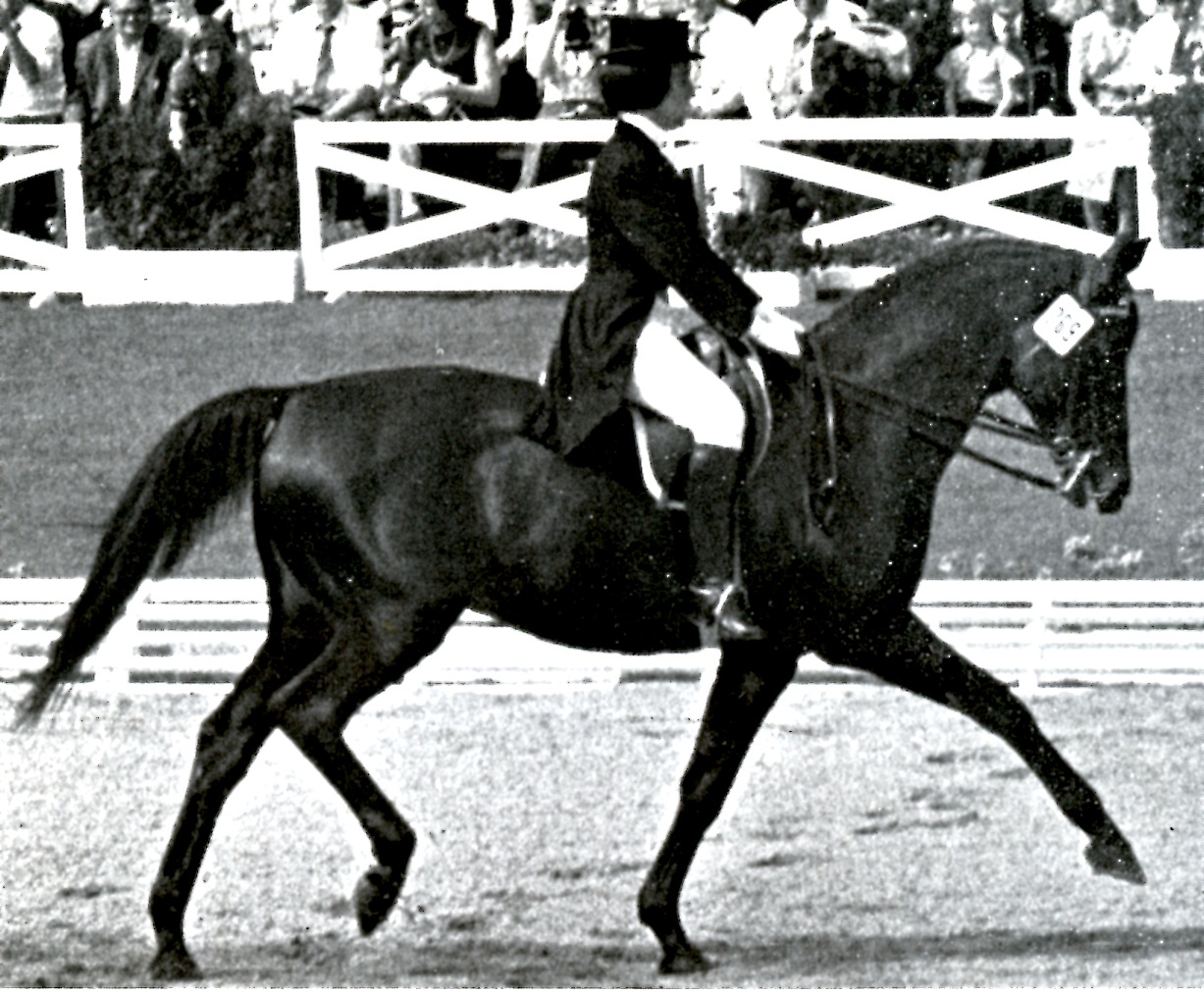
Silver to Elena Petuschkowa on Pepel
“Significantly, one of only three coefficients is attributed to the extended walk, and the walk in the different speeds is to be scored three times. This gives proof of concept and system in the construction of this test, for the walk more than the other paces reveals the correctness of training.”
“After the harmonious structure of the beginning the observer is disappointed by the way the two half pirouettes at the walk are laid out. These exercises are not well presented. When the distances for the turn is deducted there remains a stretch of not more than sixteen metres for the two of them. Besides, it seems illogical to award to these short exercises alone three of the total of thirty eight marks.”
“The sport of dressage advocates the classical principles of horsemanship, which proclaim the preservation of the horse’s natural movements. From this point of view the lay-out of the passage is incomprehensible. For three passages interrupted by two piaffes the rider has a distance of ninety-six metres complicated by six turns of ninety degrees. Here dressage perilously approaches circus riding. The passage, which in nature derives from a not fully released urge to go forward, consequently becomes an unaesthetic movement full of tenseness. This was clearly seen with most riders and stands in gross contrast to the promising beginning of the test.”
“The extended canter, on the other hand, is very logically required before the two pirouettes on the center line. Here the rider has a chance to produce sufficient impulsion in his horse to guarantee the performance of an elastic, rhythmic pirouette. The observer misses the exercises of riding with the reins in one hand and of giving the reins completely, preferably at the canter. These would contribute considerably to rounding off the over-all evaluation of horse and rider, as they are visible proof of absolute balance and of full harmony between the creatures. Furthermore, they would underline that the sport of competitive dressage naturally develops from basic general horsemanship and must never be anything like circus riding.”
“By means of the ride-off the individual medalists were selected among those competitors who qualified for it in the principal test. Since the scores of the principal test no longer count for the final evaluation, it is necessary and correct to demand again, in a different routine, the exercises that best reveal the basic training of the horse. In this respect the beginning of the ride-off is logically constructed. With a great variety of work at the trot the rider is offered a good opportunity to present his horse’s impulsion and perfect balance, especially when riding through the comers of the arena at the extended trot. Changes of tempo rapidly alternating in short distances are the criterion for a sound foundation of schooling to be expected in a dressage horse of Olympic standard.”
“I regret to say that in this exercise most riders displayed the horse’s inability to produce a true extended trot immediately followed by a vivid and supple collected one – the fortissimo and the pianissimo of riding.”
“Without consulting the programme of the test it was often difficult for the observer to find out what the rider was trying to perform. The brilliance of this exercise was too often lost in the indistinguishable uniform tempo in which it was presented. The periods of passage and piaffe were again to be ridden in the same unattractive bends and turns which had already interfered with the smooth continuation of movement in the principal test.”
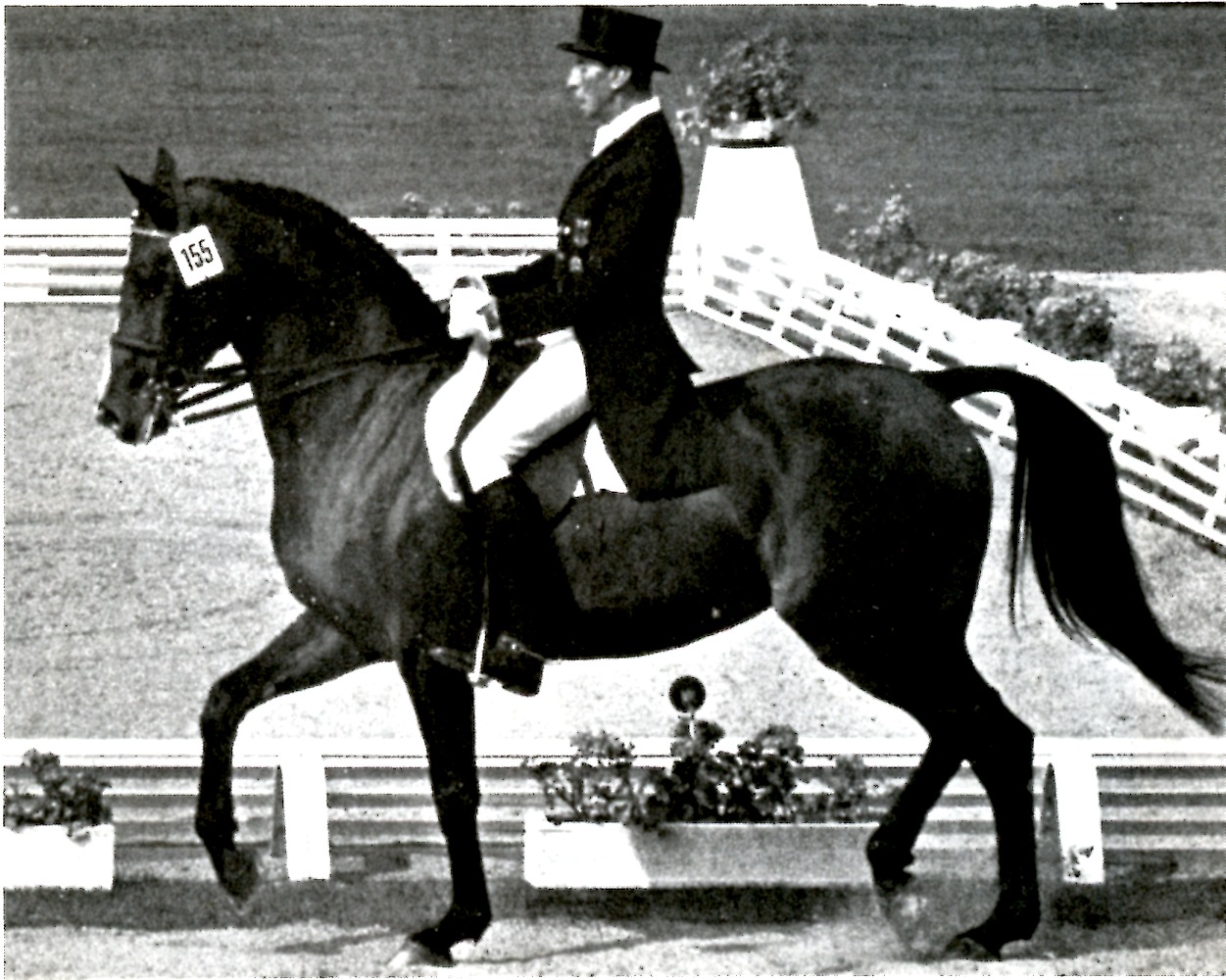
Josef Neckermann on Venetia – bronze
“In both tests the harmonious flow of the different movements was encumbered by all sorts of kinks and curls, just as the rapid sequence of some exercises confused certain riders and hampered their performance. Consequently, watching thirty-three riders going through the test sometimes became tedious for even the most interested observer.”
“This may be the explanation for the spontaneous applause with which the public received the British dressage rider Mrs. Lorna Johnstone on El Farruco. It was certainly prompted less by respect for the old lady than by the pleasure and relief after hours of watching the test to see at last a rider demonstrate distinct changes of speed and sportsmanlike impulsion.”
“The jury consisted of five judges who were strictly separated from each other. They had to form their opinions in total seclusion and dictate their evaluations, along with short remarks, if necessary, to their secretaries. After each ride the completed test sheets were taken to the scoring office. In the shortest possible time the results were evaluated and listed on the score board for everyone to see.”
“The course of the Grand Prix unwound swiftly and the schedule was generally observed, which was a pleasant contrast to the endless conferences between the rides at the Grand Prix in Mexico in 1968. The members of the jury were presided over by Colonel Nyblaeus (Sweden) here named Judge C, who was seated at the center of the short side. General de Breuil (France), on the short side at the president’s left, is named Judge M. Mr. Herrera (Mexico) on the short side at the president’s right is Judge H. Colonel Pollay {F.R.G.), at the center of the long side to the left, is Judge E. Mr. Pot (Netherlands), at the center of the long side to the left, is Judge B.”
“In the principal test the judges classified riders of their own nation as follows (the final placing is given in parentheses) :
Judge C (Sweden) Hakansson 331 marks on place 2 (5)
Swaab 316 marks on place 7 (7)
von Rosen 313 marks on place 9 ( 11)
Judge M (France) Le Rolland 306 marks on place 20 (23)
Judge E ( F.R.G.) Linsenhoff 368 marks on place 1 (1)
Neckermann 350 marks on place 2 (3)
Schlüter 319 marks on place 9 (9)
Judge B (Dutch) van Doome 305 marks on place 17 (18)
Benedictus 301 marks on place 21 (27)
Swaab 210 marks on place 27 (28)
In the ride-off the judges scored:
Judge C (Sweden) Hakansson 226 marks on place 2 (6)
von Rosen 215 marks on place 6 ( 8)
Swaab 210 marks on place 8 ( 10)
Judge E ( F.R.G.) Linsenhoff 254 marks on place 1 (1)
Neckermann 247 marks on place 2 ·(3)
Schlüter 233 marks on place 3 ( 7)
Podhasky sums up:
“And now a few comments about the method of judging and the judges themselves, whose performance was criticised by the press of practically all competing nations.”
“We have already discussed the development of and the attempts to improve the system of judging during the sixty years since the inclusion of this branch of the sport in the Olympic Games. In Munich, at last, the long-time demand made by equestrian circles was granted. The judges were no longer to compare and to correct the results of their marks before the publication of the scores, dragging out the time of the dressage competition by long-winded discussions. They were to announce their evaluations immediately after the scores had been added. Thus each judge was openly taking the responsibility for his judging.”
“However, the term “system of open judging” is pertinent to a limited degree only. For at best it was possible for a rider to consult his own score sheets but none of the others, which would reveal how the individual marks produced the final result.”
It was still nationalistic and judging that is difficult to follow:
“For six riders the difference between the highest and the lowest place marks given by the different judges is from two to four places. Such differences might be tolerated considering the numerous groups of exercises to be judged. This tolerance, however, is no longer admissible for those cases in which the difference amounts to six and seven places, as occurred with three riders, and to eight places as with four riders. Moreover, two riders were respectively scored with differences of nine and eleven places, and for one rider differences amounted to fourteen, sixteen, twenty, twenty-one, and twenty-two places. In the face of such facts it is difficult to speak about a uniform concept of dressage riding among the judges in Munich.”
“When comparing the sum of the marks, the contrasts do not become so obvious at first sight. They leap to the eye, however, when ranging the riders according to their place marks. Of course, the individual judge’s score sheet for one rider may very well differ from the same rider’s score sheets from the other judges. After all, there is a choice of scores. Good performances may be rewarded by ten to eight marks, sufficient ones by seven to five, and insufficient ones by four to one. As a result, a severe evaluation is never of disadvantage when determining the winner according to place marks, provided, of course, that all riders are judged in the same manner and in just relation to each other. No allowance should be made for riders of one’s own country or for friends, nor should opponents of one’s countrymen or riders who do not appeal to the judge be judged differently.”
“It is a vital part of the judge’s character that he does not allow himself to be influenced in any way in his judging but puts his entire knowledge and understanding into the cause. Chauvinism, from which we have unfortunately not yet freed ourselves, is just as objectionable as lack of knowledge or the inability to express an opinion of one’s own. A judge of that kind should have no place in small national horse shows and certainly none at an event such as the Olympic Games. Not only the experts but also other attentive observers were struck by the large differences in the evaluations of the dressage riders in Munich.”
“Part of the press, as an excuse, pointed out that the judges placed on the short side of the dressage arena had a different field of vision than those seated on the long sides. Fundamentally, this statement is correct. The judge seated at the front of the arena may see many things better than the judge seated at the side. On the other hand, the judges placed on the sides have a better view than the rest of the judges of many faults that may occur during the frequent turns from one long side of the arena to the other required in this test.”
“However, the comparison of results I have charted clearly shows that the serious differences in place marks were to be found among the three judges placed on the short sides of the arena. Here the difference between the highest and the lowest place marks was of: 0 to 4 places with 13 riders, 5 places with 1 rider, 6 places with 4 riders, 7 places with 3 riders, 8 places with 2 riders, 9 places with 3 riders, 10 places with 2 riders and with one rider respectively 11, 12, 13, 14, and 22 places.”
“With the two judges seated at the long sides of the arena, the difference in the place marks was of: 0 to 4 places with 22 riders, 5 places with 3 riders, 6 places with 1 rider, 7 places with 4 riders and with 1 rider respectively, 8, 11, and 12 places.”
“Indeed as already remarked, it is sometimes very difficult for a judge to evaluate with justice if the performances of the riders are of a low standard. It is even more difficult to place the riders correctly if there are thirty or more on an equal level. The conscientious judge would admit that it is practically impossible to be absolutely just in his evaluation even with the utmost impartiality when he sees so large a number of riders in only one test. He should therefore welcome the opportunity to see the riders a second time, as is the case now in the ride-off.”
“When studying the names of the judges who composed the juries of the Grand Prix de Dressage at the Olympic Games in the past decades it is with surprise and consternation that one notes that quite a few of them were never dressage riders and cannot boast of any achievements in this sphere, such as winning trophies or being outstanding as teachers. When there is a music contest of any international importance nowadays, nobody totally unknown in this field would be called into the jury.”
“Therefore, it is doubly incomprehensible that dressage judges often come from countries that have never delegated any riders to compete or who have not participated for several decades. How could such judges give a clear concept for the riders if they themselves have never demonstrated in practice the correctness of their ideas? At the Olympic Games, as the greatest athletic event, supreme performances should be expected from all participants. Therefore once more: the best riders of the world deserve the best judges of the world.”
It would seem that the three judges who high scored a lame Totilas in the GP at the Aachen Euros 2015 – Anne Gibbons – 79.3, Susanne Barup – 80.1 and Andrew Gardner – 80.1 – were merely following customary practice:
“And as with previous Olympic contests, the dressage tests in the beautiful Nymphenburger Park produced a scandal, which, however, this time did not spring from chauvinism as in Stockholm in 1956. It was inconceivable from the outset that a rider with a lame horse was allowed to ride the test through to the end and even more so that he was placed twenty-ninth by two judges, twenty-eighth by the third, and twentieth by his compatriot. It is downright shocking, however, that one of the judges awarded him seventh place in a field of thirty three riders. Any further comment is superfluous and it is to be hoped that the FEI investigated the matter. The spectators, very well behaved otherwise, made their decision there and then and gave vent to their opinion by booing loudly.”
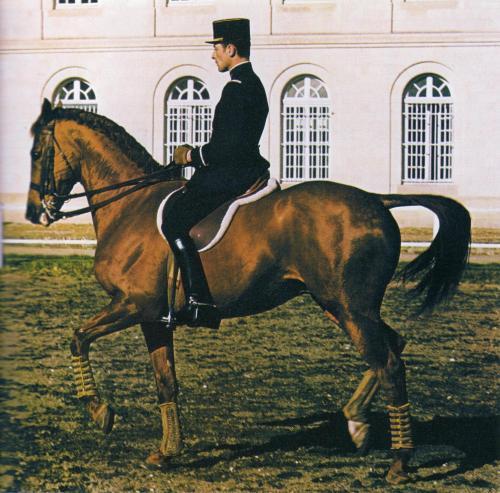
Podhajsky does not name the horse, but from his charts of individual results
it is easy to see that it was the one French combination at the Games,
Patrick Le Rolland and the ex-steeplechaser, Cramique…
Want to breed a modern star for the dressage arena? International Horse Breeders have the best bloodlines in Australia: www.ihb.com.au

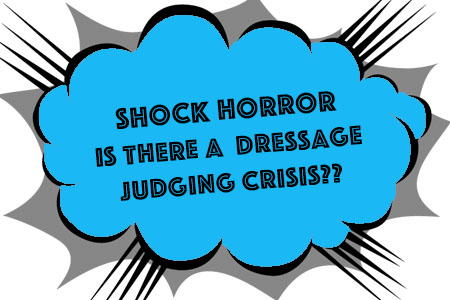

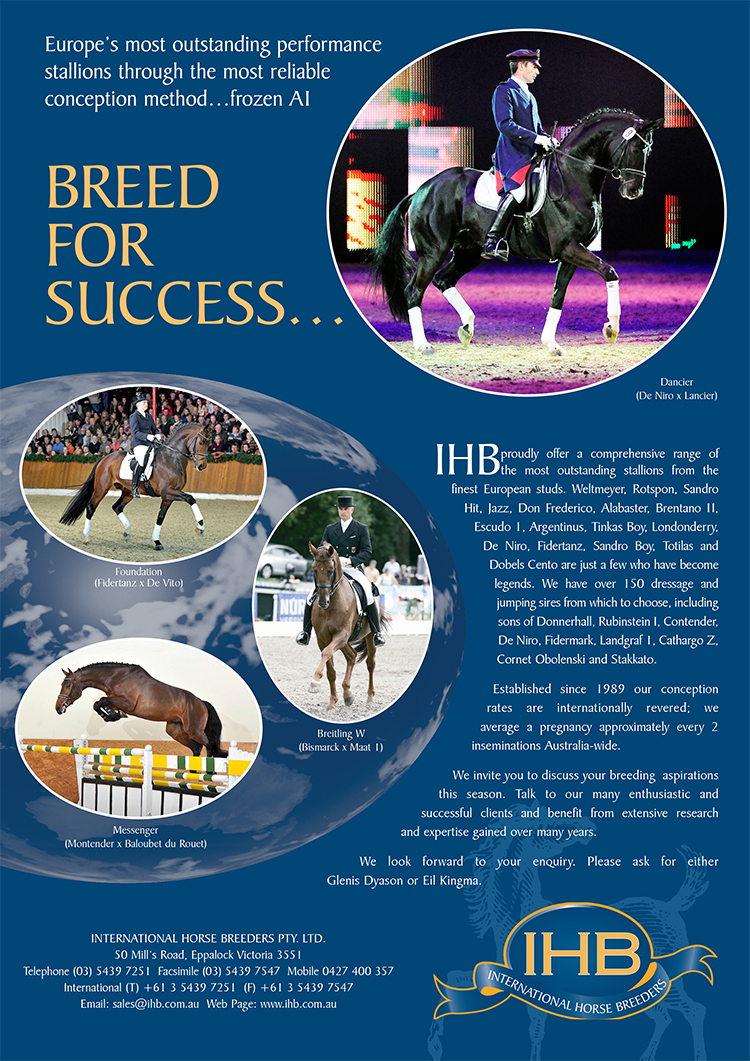
”Anky was riding an M class and Isabell GP” Really ???????
And there we have one of the main issues with dressage judging , the willingness to use ones bias to judge on nationalistic grounds . It shouldn’t matter at all if you are German , Dutch or any other nationality , but in the first few lines of the article is the proof that it does.
The fact that “Dressage” today is mostly Circus movements that are scored as Classical Dressage when none of the Principals of Classical Dressage are shown in the test. From the way the rider sits…….Look at the saddles riders ride in today! Are we Jousting!
The broken necks, Short necks, Flat backs. Piaffe like movements that are not Piaffe. The list goes on.
If the Judges today have never seen a Classically trained horse nor ridden in a Classical System what are they basing their scores on?
A fascinating & extremely interesting article.